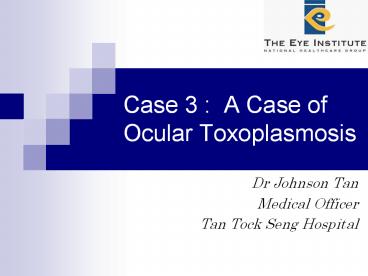Case 3 : A Case of Ocular Toxoplasmosis - PowerPoint PPT Presentation
1 / 18
Title:
Case 3 : A Case of Ocular Toxoplasmosis
Description:
Rt superior optic disc swelling superiorly ... Bactrim (2 tabs bid) is as effective as pyrimethamine/sulfadiazine for lesions outside fovea. ... – PowerPoint PPT presentation
Number of Views:1194
Avg rating:3.0/5.0
Title: Case 3 : A Case of Ocular Toxoplasmosis
1
Case 3 A Case of Ocular Toxoplasmosis
- Dr Johnson Tan
- Medical Officer
- Tan Tock Seng Hospital
2
Mr SCHA
- 17/Chinese/male
- c/o
- RE floaters x 5 days
- No trauma
- O/E
- VA 6/7.5 OU
- No RAPD
- Colour 15/15 OU
- Decreased red desaturation RE
- Confrontational fields full
- Anterior segment NAD
- RTL cells 1
3
On examination of RE,
4
- What were the findings?
- Rt superior optic disc swelling superiorly
- Superior-temporal peripapillary white lesion with
indistinct edges - Adjacent vasculitis
- What would be the next step?
- Take a full history
5
Further questioning
- No headache / neck stiffness / tinnitus
- No joint pains
- No mouth ulcers
- No dysuria
- No travel history
- No chronic cough / fever / constitutional
symptoms - No contact history with TB
6
Investigations
- ESR / CRP
- ANA, dsDNA
- ANCA
- CXR / Mantoux
- VDRL/TPHA
- Toxoplasma IgG 18.7 IU/ml (positive)
- Aqueous tap for CMV/HSV/VZV/Toxoplasma /TB PCR
not detected
NORMAL
7
Ocular Toxoplasmosis
- Obligate, intracellular parasite
- Commonest cause of retinochoroiditis and
posterior uveitis - Manifest between the 2nd 4th decades of life
- Risk factors
- Immunodeficiency states
- Exposure to cats
- Eating raw or partially cooked meat
- Symptoms
- Blurred vision
- Floaters
- Pain
- Red eye
- Metamorphopsia
- Photophobia
8
Ocular Presentations
- Iridocyclitis
- Unifocal superficial necrotizing
retinochoroiditis - Classical presentation involving inner retina
- Surrounded by oedema with contiguous inflammation
of choroid and sclera - May be a/w dense vitritis ? "headlight in the
fog" - May be a/w adjacent focal vasculitis ? kyrieleis
arteriolitis - Jensens papillitis
- Involvement of optic nerve from adjacent
juxtapapillary retinitis - Optic nerve sheath may serve as a conduit for the
direct spread of Toxoplasma into the optic nerve
from an adjacent cerebral infection ? optic
neuritis/papillitis - Punctate outer retinitis - rare
- Deep retinitis - rare
9
Uncommon Ocular findings
- Ocular inflammation without necrotizing
retinochoroiditis - Retinal and optic nerve neovascularization,
usually regresses with resolution of
inflammation. - Exact aetiology not well understood
- Retinal ischemia associated with severe retinal
vasculitis - Inflammatory reaction
10
Optic neuritis vs disc swelling from contiguous
spread?
Optic neuritis Disc swelling from contiguous spread
VA P
Colour P
RAPD P
VF
11
Ocular Toxoplasmosis
- Immunocompetent adults
- Unilateral, painless. unifocal
- Vision good if macula not involved
- Neonates
- Congenital toxoplasmosis
- Bilateral, severe
- 70 retinochorioditis
- ? macula involved a/w severe visual loss
- Micorophthalmia, vitritis, glaucoma, ocular
palsies - Immunocompromised
- Bilateral, multifocal, severe
- May be a/w SOL of CNS ? Ocular palsies,
nystagmus, VF defects
12
Follow-up
- Bactrim 11/11 bid x 1/12
- Prednisolone 1mg/kg (50mg od) tapered over 2
weeks
13
Typical Presentation Course
14
Serological diagnosis
- IgG
- IgG seroconversion 2-4 weeks after systemic
infection, peak titres 4-6 weeks after infection - Titres maintained at high levels for many months
or years. - Recent infection 4x rise in antibody titres
over a 2-4 week period - Clinical signs may develop before seroconversion
occurs, or after peak titres have developed. - A single antibody titre is difficult to interpret
and is rarely of any value - Negative IgG excludes ocular toxoplasmosis
15
Serological diagnosis
- IgM
- Less value than IgG
- A negative IgM test excludes recent infection
- A positive IgM test is difficult to interpret
because Toxoplasma-specific IgM antibodies may be
detected up to 18 months after acute acquired
infection - Goldmann-Witmer coefficient
- Ratio of Toxoplasma IgG eye serum gt 3 is
generally accepted as being consistent with
active ocular infection - But invasive procedure!
- Aqueous humor and serum immunoblotting for
immunoglobulin types G, A, M, and E in cases of
human ocular toxoplasmosis. J Clin Microbiol.
2004 Oct42(10)4593-8.
16
PCR
- Presence of T. gondii in ocular fluids is
detected on PCR considered to be confirmation of
active eye disease - A negative finding does not exclude ocular
toxoplasmosis - Real-time PCR (Light-cycler, LC-PCR) more
sensitive than nested PCR (n-PCR). - Evaluation of a Real-time PCR-based assay using
the lightcycler system for detection of
Toxoplasma gondii bradyzoite genes in blood
specimens from patients with toxoplasmic
retinochoroiditis. Int J Parasitol. 2005
Mar35(3)275-83. Epub 2005 Jan
17
Treatment Updates
- Triple drug therapy pyrimethamine, sulfadiazine,
prednisolone - Quadruple therapy pyrimethamine, sulfadiazine,
clindamycin, prednisolone. - Bactrim (2 tabs bid) is as effective as
pyrimethamine/sulfadiazine for lesions outside
fovea. - 61 in classic triple therapy grp vs 59 in
Bactrim grp - Soheilian et al. Prospective randomised trial of
Trimethoprim/sulfamethoxazole vs pyrimethamine
sulfadiazine in the treatment of ocular
toxoplasmosis. Ophthalmology. 2005
Nov112(11)1876-82 - At least 6 weeks treatment
- Others Azithromycin pyrimethamine (AJO
200213434-40) - Spiramycin (Klin Montasbl Augenheildk
199821284-7) - Atovaquone (hydroxynaphthoquinone)
(Ophthalmology 1999106148-53) - Allopurinol (Adam et al. Berlin 2000)
- Corticosteroids
- Topical depending on AC reaction.
- Depot absolutely contraindicated
- Risk of rampant necrosis and blind, phthisical
globe - Systemic adjunct to minimize collateral damage
from the inflammatory response - Usually from Day 3 _at_ 1mg/kg, tapered over 2 weeks
18
Thank you
A presentation by The Eye Institute _at_ Tan Tock
Seng Hospital































